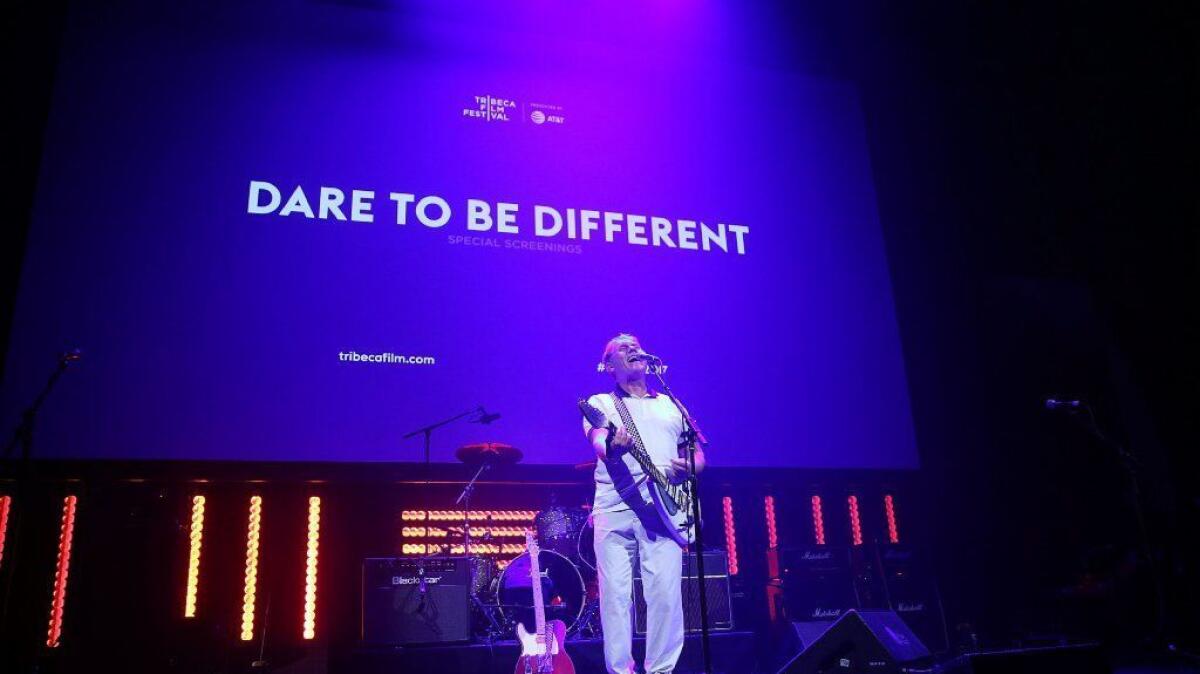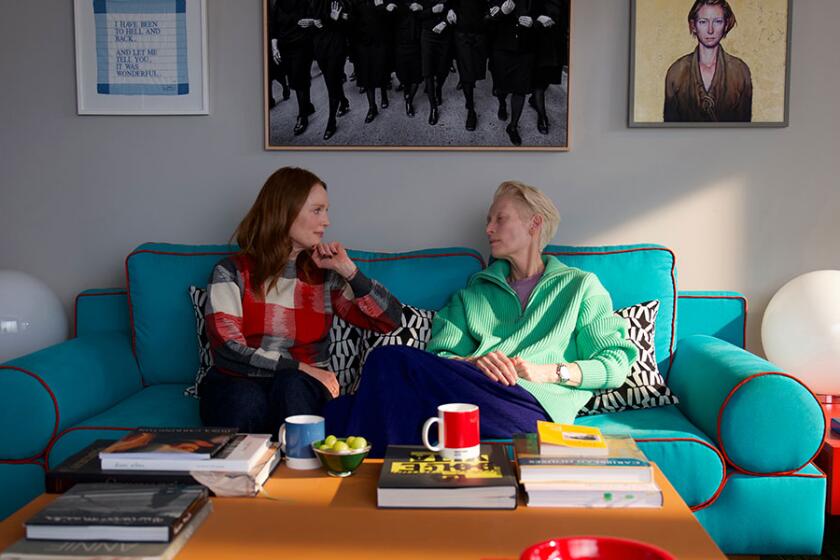From technology to tear-jerkers to TV, what we learned at the Tribeca Film Festival

- Share via
One of the great advantages of a gathering like the Tribeca Film Festival is the sheer variety of what’s on offer. Populating screens are not only a wide range of documentaries and narrative films but television and tech programming — not to mention numerous concerts, talks and retrospectives.
From one perspective of course, that can seem like chaos. And granted, the fest’s many niches can make for an overwhelming, at times muddying affair.
Is Tribeca the festival of nostalgia, where “The Godfather” and “Reservoir Dogs” get anniversary screenings and talks (as they did this past weekend), where vintage radio programs are fondly remembered with in-person reunions?
Or is it a festival of the moment, where documentaries like “Get Me Roger Stone” and the Oregon-standoff film “No Man’s Land” — not to mention a wide selection of new VR and digital efforts — take center stage? (Heck, even Hillary Clinton turned up to support one.)
Should it be considered a more traditional place of cinematic discovery, as a series of narrative films get their world premieres and seek the distribution to help them break out in the wider world? Or is it more about the experience around the movies, with post-screening concerts from the likes of Carly Simon and Puffy, and talks between Tom Hanks and Bruce Springsteen?
The jury is out. And may never, in a sense, come back. But for Tribeca, which Sunday wrapped up its 16th year under the hand of Robert De Niro and producing partner Jane Rosenthal, that’s OK. What seems like a throw-it-at-the-wall exercise to some is exactly the kind of tapestry its organizers want — an event that, much like the city it inhabits, offers a little something for everyone.
Here’s a small sample of the diversity I experienced over the past 12 days.
The undeniable breakout of the festival was “Keep the Change,” winner of the jury prize for best narrative feature. Rachel Israel’s feature debut is an offbeat romantic comedy — but not the kind of offbeat romantic comedy typically associated with film festivals.
Based on an earlier short, “Change” centers on people on the autism spectrum, particularly David (Brandon Polansky) and Sarah (Samantha Elisofon). The pair meet in a group therapy setting in uptown Manhattan and proceed to navigate a range of challenges as they pursue a relationship. An authentic romance between people who are not neuro-typical is rare enough; making it more distinct is that Israel shot it with non-actors who are themselves on the autism spectrum, building the script around them over an intensive, years-long development process.
Last Friday, Israel sat in the offices of a New York publicity firm and described the unusual journey — and her motivation for making it in the first place.
“I was struck by the relationships of this group — their ability to have beautiful, wonderful and dysfunctional relationships— to love each other and yell at each other and take care of each other,” she said. “And I felt like I hadn’t really seen that on film before.”
Sundance opted not to accept the film, which may be to the Utah festival’s detriment: Like another movie about people with behavioral challenges that went elsewhere after Sundance turned it down (2013’s “Short Term Twelve,” which debuted at SXSW), “Keep the Change” is likely to garner plenty of buzz for itself and Tribeca in the months ahead.
Television is becoming an important part of the festival landscape generally, but Tribeca embraces it a bit more than others. There were screenings for National Geographic’s Albert Einstein story “Genius” and Michael Winterbottom’s “The Trip to Spain,” the third series of
Social media dissected star Elisabeth Moss’s comment after the premiere that the Margaret Atwood story is “not a feminist story. It’s a human story because women’s rights are human rights.” That debate aside, she left little doubt about her desire to tackle the project; though she wasn’t looking for a new post-”Mad Men” series, “I said,‘I think I should do this. I think I have to do this.’ Eventually I got to the point where I thought if I don’t decide soon, someone else would do it. And that made me so … jealous I had to do it.”
Virtual reality’s presence continued to grow at Tribeca, with world premieres of several dozen new pieces from creators who test the boundaries of the medium while making worthy and wide-ranging content in their own right. There were films from traditional film types such as Kathryn Bigelow (the endangered-elephant tale “The Protectors”) and new-era filmmakers Chris Milk (his Within company was behind experiential works such as “Hallelujah” and “Hoverboard”). There were actors like Emily Mortimer and Alessandro Nivola (the police-investigation thriller “Broken Night”) and mainstay cinematic subjects, including the Holocaust, done in potent new ways (Gabo Arora and Ari Palitz’s visit-to-Majdanek piece “The Last Goodbye”).
Technology wasn’t just contemplated on new platforms. In the traditional flat-screen documentary “AlphaGo,” director Greg Kohs looked at how a program created by Google's DeepMind team challenged a champion in the complex game of Go, and what that says about the limitations for humans and new frontiers for machine learning.
Demis Hassabis, the head of DeepMind, was among those who appeared at a post-screening panel the festival’s first weekend. “For me, AlphaGo was a little bit for [the A.I. world] like the Hubble telescope for astrophysicists,” he said. “‘Here’s a tool they can use to see the cosmos around them.’”
Documentary can be at its best when it’s about nostalgia. And nostalgia rarely feels as strong as when it focuses on radio, a medium practically designed for the feeling. A pair of movies at Tribeca capitalized on this in their own way.
In Daniel Forer’s “Mike and the Mad Dog,” the seminal, provocative partnership of Mike Francesa and Chris “Mad Dog” Russo was explored, a combustible sports-radio pairing that helped create the genre back in the 1980s and ‘90s. The screening on April 21 morphed into a kind of live call-in show as people in the audience began reenacting bits from before the pair broke up in 2008.
"Hi, it's Mark from Bellmore," said a man at the very back of the theater. "When I come home from a trip," he continued, "it sounds like home. I almost drove off the Grand Central when Piazza signed with the Mets — I almost caused a 10-car accident."
Meanwhile, a station of a different sort was celebrated in Ellen Goldfarb’s “Dare to be Different,” a tale of New York’s influential and long-defunct WLIR. In the 1980s, LIR, in defiance of popular taste and often international copyright law, became the first station to play imports like U2, Depeche Mode, Howard Jones, A Flock of Seagulls, Joy Division, Duran Duran and other new wave bands.
Run by Denis McNamara, the station was the epitome of cool, if also a kind of, er, low-budget chic; LIR operated at a time when culture was more about discovery than corporations and technology. The film told its story and showed the personalities at its center — McNamara, the musicians, deejays such as Malibu Sue and Larry the Duck. Many from that era turned out last Thursday for what became a kind of high-school reunion of new wave music too. A post-screening event, emceed by McNamara, featured performances from the Alarm, the English Beat and A Flock of Seagulls.
“This one I want to dedicate to LIR,” Seagulls frontman Mike Score said before playing the band’s hit “Space Age Love Song.” “It's gone but the memory lingers on.”
It wouldn’t be a festival without dramas. They’re the mother’s milk of every movie gathering. And this year’s Tribeca was flowing with them.
Among the world premieres that stood out are Russell Harbaugh’s “Love After Love,” in which Andie MacDowell plays a woman who must keep the family together, in her own way, after the patriarch passes. In Nathan Silver’s “Thirst Street,” a flight attendant enters an obsessive mode after a breakup. And in Azazel Jacobs’ “The Lovers,” Tracy Letts and Debra Winger play a married couple who find reconciliation after years of affairs, in a movie that veers between farce and humanist.
Sometimes, as you move away from film, you have to remind people it’s all about film.
See the most-read stories in Entertainment this hour »
Twitter: @ZeitchikLAT
Only good movies
Get the Indie Focus newsletter, Mark Olsen's weekly guide to the world of cinema.
You may occasionally receive promotional content from the Los Angeles Times.








